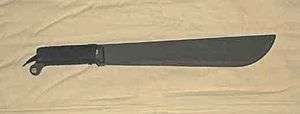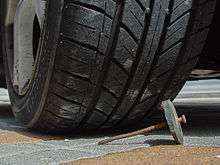Improvised weapon
An improvised weapon is an object that was not designed to be used as a weapon but can be put to that use. They are generally used for self-defence or where the person is otherwise unarmed. In some cases improvised weapons are commonly used by attackers in street fights, muggings, murders or during riots, usually when conventional weapons such as firearms are unavailable or inappropriate.
Improvised weapons are common everyday objects that can be used in a variety of defensive applications. These objects are not physically altered in any way, in an effort to make them more functional as weapons. They are generally utilized in their normal state.[1]
Examples
Other than items designed as weapons, any object that can be used to cause bodily harm can be considered an improvised weapon. Examples of items that have been used as improvised weapons include:
- Sports equipment such as baseball bats,[2] golf clubs,[3] cricket bats[4] and dumbbells[5]
- Objects made of glass, such as beer bottles[6]
- Tools such as sledgehammers,[7] tire irons,[8] shovels[9] and fire extinguishers[10]
- Construction materials, such as 2×4s,[11] pipes[7][12] and bricks[13][14]
- Natural materials, such as rocks[15]
- Vehicles, including rental trucks,[16] light aircraft, such as a Piper PA-28-236 Dakota[17] and airliners, such as the Boeing 767[18]
Improvised weapons in martial arts

Throughout history, common tools were used so often as weapons in self-defense that many of them have evolved specifically into weapons or were adapted with the secondary purpose of being used in self-defense, usually by adding modifications to its design. Well-known examples include the Irish shillelagh, the Japanese Bō and hanbo, which were originally used as walking canes and the Buddhist Monk's spade, a shovel monks used for burying corpses which often had sharpened edges to defend against bandits with more ease.
Many martial arts employ the use of common objects as weapons; Okinawan karate features items of farming equipment that were later used as weapons by Okinawan peasants due the prohibition of weapons imposed by the shogun regime during feudal times; Filipino martial arts such as Eskrima include practice with machetes, canes, bamboo spears, and knives as a result of the 400 year Spanish colonization that took place in the Philippines which prohibited the ownership and use of standard swords and bladed weapons;[19] Chinese martial arts and some Korean martial arts commonly feature the use of improvised weapons such as fans, hammers and staves. There are even some western martial arts that are based on improvised weapons such as British quarterstaff fighting and Irish stick fighting.[20]
After the German Peasants' Wars during 1524-1525, a fencing book edited by Paulus Hector Mair described in 1542 techniques how to fence using a scythe.[21]
Legal issues
Because of the use of common objects as weapons in violent crimes, many countries have laws that prevent the use of some tools and other non-weapon objects to be used for causing harm. It is possible for a person to be detained, or even arrested, by a law enforcement official or security personnel for carrying a potentially-harmful object in a situation where there is no reasonable use for it. For example, while it is legal and perfectly understandable for someone to possess a kitchen knife or a hammer and keep it for use in one's home, it could be judged suspicious for someone to carry a kitchen knife or a hammer concealed on his/her person or in plain sight when walking down a city street.[22]
There are places that prohibit people from entering with objects that may be used as weapons. Most public schools in North America do not allow their students to bring pocket knives, butter knives[23][24] or chain-wallets,[24] sometimes with harsh zero tolerance policies. Airports typically prohibit objects that could be used as weapons from being carried onto aircraft. The security repercussions after the September 11 attacks saw restrictions widely extended to cover even objects like nail clippers and spiked wristbands,[25][26]
Makeshift weapons

A makeshift weapon is an everyday object that has been physically altered to enhance its potential as a weapon. It can also be used to refer to common classes of weapons such as guns, knives, and bombs made from commonly available items.[1]
Examples of makeshift weapons include:
- Millwall brick
- Molotov cocktail
- Pipe bomb
- Shiv
- Improvised firearms
- Chainlock (improvised flail)
- Stink bomb
- Smoke bomb
- Blackjack/Sap
- Improvised explosive device
The improvised Molotov cocktail was used with great success by the heavily outnumbered Finnish forces in the Winter War against the Soviet Union. The mixture of flammable petroleum, often thickened with soap or tar, was so effective against the Soviet tanks that the Finns began mass producing Molotov cocktails, and issuing them to their troops. While the first documented use of such improvised incendiary devices was in the Spanish Civil War, their use in the Winter War was much more prevalent, and it was at that time they were named after the Soviet Foreign Minister Vyacheslav Mikhailovich Molotov.[27]
See also
References
- 1 2 DEFENSIVE USE OF IMPROVISSED (sic) WEAPONS
- ↑ Baseball bat as used was a deadly weapon
- ↑ Mayorga, Carlos (May 2010). "N. Ogden man charged in golf course assault with deadly weapon". Retrieved 5 June 2010.
- ↑ Self defence or malicious revenge? Jail for brothers who beat burglar with bat
- ↑ TribStar.com (February 2008). "Wabash Valley Correctional Facility inmate in critical after attack". Retrieved 5 June 2010.
- ↑ Ratcliffe, Michael J. (August 2008). "Police say broken bottle was wielded as weapon in Princeton robbery". Retrieved 5 June 2010.
- 1 2 "The Lawyers reports annotated, Volume 21" Page 506
- ↑ Carson City deputies arrest three after fight with tire iron
- ↑ FM 3-25-150 Chapter 7
- ↑ WGHP (2006). "Weapon of choice: Fire extinguisher". Retrieved 5 June 2010.
- ↑ "The Lawyers reports annotated, Volume 21" Page 504
- ↑ Man accused in fatal lead pipe beating pleads not guilty
- ↑ Times on line (February 2010). "Mayfair partygoers throw bricks at riot police". The Times. London. Retrieved 5 June 2010.
- ↑ Gregory, Chris (May 2010). "Attack happened in Kings Furlong". Retrieved 5 June 2010.
- ↑ Hadad, Shmulik (May 2010). "9 officers hurt in east Jerusalem riots". Retrieved 5 June 2010.
- ↑ Ottley, Ted. "Imitating Turner". Timothy McVeigh & Terry Nichols: Oklahoma Bombing. TruTv. Retrieved April 10, 2010.
- ↑ Austin American Statesman Coverage of Plane Crash
- ↑ "Twin Towers Demolished, Pentagon Hit in Terrorist Attacks". Foxnews.com. 2001-09-12. Retrieved 2008-06-10.
- ↑ Escrima - The Filipino Martial Art
- ↑ Hurley, John W. (2007). Shillelagh: The Irish Fighting Stick. Caravat Press. ISBN 1-4303-2570-4.
- ↑ Digitale Bibliothek - Münchener Digitalisierungszentrum
- ↑ Chef Nate Appleman busted for weapons possession, a little jackknife - NYPOST.com
- ↑ One Nation Under Arrest: The End of the Pocket Knife
- 1 2 Girl arrested for butter knife in backpack
- ↑ Post-9/11 Airport Security: Do You Know Where Your Dignity Is?
- ↑ TSA: Prohibited Items
- ↑ History of the Molotov cocktail